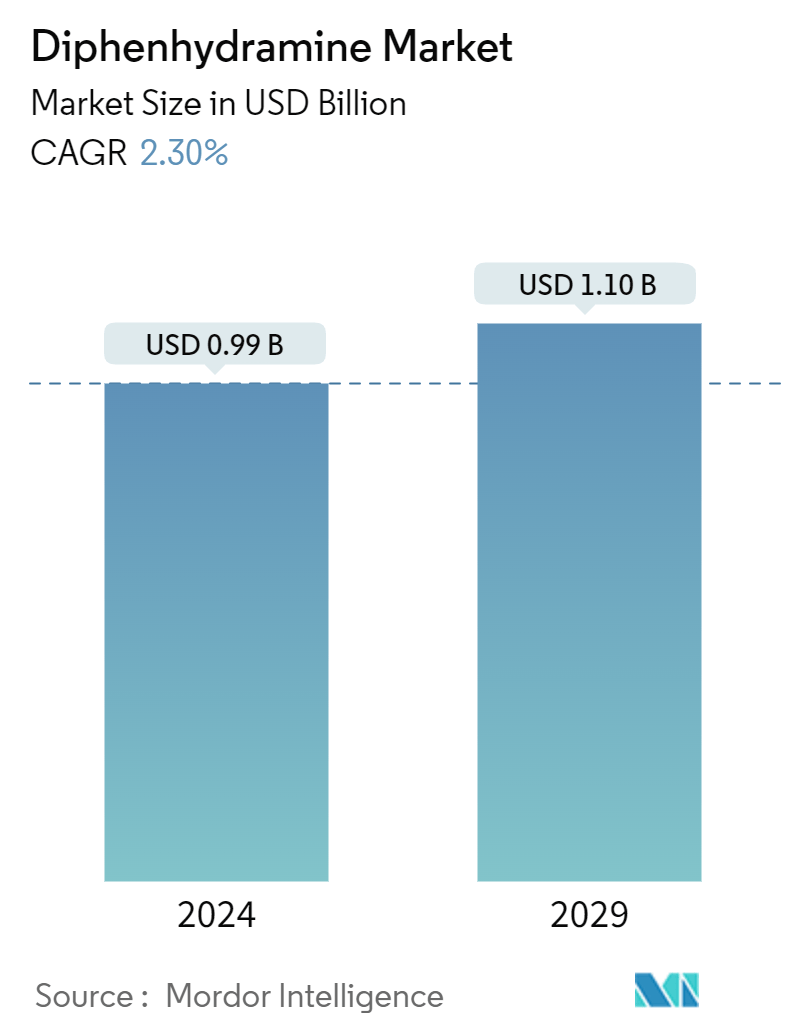Market Size of Diphenhydramine Industry

| Study Period | 2019 - 2029 |
| Market Size (2024) | USD 0.99 Billion |
| Market Size (2029) | USD 1.10 Billion |
| CAGR (2024 - 2029) | 2.30 % |
| Fastest Growing Market | Asia-Pacific |
| Largest Market | North America |
| Market Concentration | Medium |
Major Players
*Disclaimer: Major Players sorted in no particular order |
Diphenhydramine Market Analysis
The Diphenhydramine Market size is estimated at USD 0.99 billion in 2024, and is expected to reach USD 1.10 billion by 2029, growing at a CAGR of 2.30% during the forecast period (2024-2029).
Factors such as the growing number of allergic populations, the rising prevalence of motion sickness and insomnia, and increasing research and development expenditures are expected to boost the market’s growth during the forecast period.
The rising number of people suffering from seasonal allergies is expected to increase the demand for effective medications that help reduce allergic symptoms, which is anticipated to fuel the growth of the market studied during the forecast period. For instance, according to the data published by the Centers for Disease Control and Prevention, in January 2023, approximately 25.7% of US adults reported experiencing seasonal allergies in 2022.
Similarly, as per an article published by the UK government in May 2024, about 50% of Europe's population is expected to suffer from some type of allergy sensitivity or aversion due to climate change by 2025. Thus, the expected increase in the number of people suffering from allergies is anticipated to bolster the demand for diphenhydramine, propelling the market’s growth.
The high burden of allergic rhinitis (AR) among the population is creating a huge burden on the healthcare system as well as impacting the quality of life. For instance, according to an article published in the World Allergy Organizational Journal in March 2024, allergic rhinitis affects approximately 10% to 40% of the global population, with a rising prevalence trend annually. Additionally, a study conducted to determine the prevalence of allergic rhinitis among children in Iran was published in Medi Media in May 2024; it was reported that the prevalence of allergic rhinitis surged from 5% at age 4 to a significant 14% by age 8. Thus, the increasing prevalence of allergic rhinitis raises the need for diphenhydramine in combination with other analgesics or sympathomimetic agents for combined relief of symptoms of allergic rhinitis. This is anticipated to bolster the market’s growth during the forecast period.
Furthermore, the growing prevalence of cold and flu cases globally is also expected to boost the growth of the diphenhydramine market. For instance, according to data published by the Centers for Disease Control and Prevention, in June 2024, about 35 to 64 million flu cases were reported in the United States, with 16 to 30 million medical visits from October 2024 to June 2024. Thus, the expected increase in flu cases raises the demand for medications that relieve symptoms such as runny nose, sneezing, and watery eyes, including diphenhydramine, and the availability of diphenhydramine as an OTC medication makes it accessible without the need for a prescription, boosting sales.
Therefore, owing to the aforementioned factors, such as the high burden of seasonal allergies and allergic rhinitis, the market studied is anticipated to grow during the forecast period. However, the side effects of diphenhydramine are likely to hinder the growth of the diphenhydramine market during the forecast period.
Diphenhydramine Industry Segmentation
As per the scope of the report, diphenhydramine is an antihistamine used to treat allergies, hay fever, and colds. It reduces the effect of the natural chemical histamine in the body. It is also used to prevent nausea, vomiting, and motion sickness.
The diphenhydramine market is segmented by dosage forms, application, and geography. By dosage form, the market is segmented into tablets, injections, powders, and syrups. By application, the market is bifurcated into allergies, insomnia, colds, nausea, and other applications. By geography, the market is divided into North America, Europe, Asia-Pacific, Middle East and Africa, and South America. The report offers the value (USD) for the above segments.
| By Dosage Forms | |
| Tablets | |
| Injection | |
| Powder | |
| Syrups |
| By Application | |
| Allergies | |
| Insomnia | |
| Cold | |
| Nausea | |
| Other Applications |
| By Geography | ||||||||
| ||||||||
| ||||||||
| ||||||||
| ||||||||
|
Diphenhydramine Market Size Summary
The diphenhydramine market is poised for growth, driven by increasing demand for effective treatments for allergies, motion sickness, and insomnia. The rising prevalence of seasonal allergies and allergic rhinitis, exacerbated by climate change and environmental factors, is expected to significantly boost the market. The availability of diphenhydramine as an over-the-counter medication enhances its accessibility, further propelling its demand. Additionally, the growing incidence of cold and flu cases globally contributes to the market's expansion, as diphenhydramine is sought after for its symptom-relief properties. The market's growth is also supported by the increasing research and development activities aimed at exploring new applications and formulations of diphenhydramine.
The insomnia segment is anticipated to witness substantial growth due to the rising stress levels, mental health issues, and an aging population, all of which contribute to sleep disorders. The demand for diphenhydramine as a sedative to aid sleep is expected to rise, driven by the high prevalence of insomnia among various demographics. North America is projected to hold a significant market share, supported by the high burden of allergies and insomnia in the region, along with the increasing number of international travelers experiencing motion sickness. The market's competitive landscape is characterized by strategic collaborations and product innovations by key players, ensuring a dynamic and evolving market environment.
Diphenhydramine Market Size - Table of Contents
-
1. MARKET DYNAMICS
-
1.1 Market Overview
-
1.2 Market Drivers
-
1.2.1 Growing Number of Allergic Population
-
1.2.2 Rising Prevalence of MotionSsickness and Insomnia
-
1.2.3 Increasing Research and Development Expenditure
-
-
1.3 Market Restraints
-
1.3.1 Side Effects of Diphenhydramine
-
-
1.4 Porter's Five Forces Analysis
-
1.4.1 Threat of New Entrants
-
1.4.2 Bargaining Power of Buyers/Consumers
-
1.4.3 Bargaining Power of Suppliers
-
1.4.4 Threat of Substitute Products
-
1.4.5 Intensity of Competitive Rivalry
-
-
-
2. MARKET SEGMENTATION (Market Size by Value - USD)
-
2.1 By Dosage Forms
-
2.1.1 Tablets
-
2.1.2 Injection
-
2.1.3 Powder
-
2.1.4 Syrups
-
-
2.2 By Application
-
2.2.1 Allergies
-
2.2.2 Insomnia
-
2.2.3 Cold
-
2.2.4 Nausea
-
2.2.5 Other Applications
-
-
2.3 By Geography
-
2.3.1 North America
-
2.3.1.1 United States
-
2.3.1.2 Canada
-
2.3.1.3 Mexico
-
-
2.3.2 Europe
-
2.3.2.1 Germany
-
2.3.2.2 United Kingdom
-
2.3.2.3 France
-
2.3.2.4 Italy
-
2.3.2.5 Spain
-
2.3.2.6 Rest of Europe
-
-
2.3.3 Asia-Pacific
-
2.3.3.1 China
-
2.3.3.2 Japan
-
2.3.3.3 India
-
2.3.3.4 Australia
-
2.3.3.5 South Korea
-
2.3.3.6 Rest of Asia-Pacific
-
-
2.3.4 Middle East and Africa
-
2.3.4.1 GCC
-
2.3.4.2 South Africa
-
2.3.4.3 Rest of Middle East and Africa
-
-
2.3.5 South America
-
2.3.5.1 Brazil
-
2.3.5.2 Argentina
-
2.3.5.3 Rest of South America
-
-
-
Diphenhydramine Market Size FAQs
How big is the Diphenhydramine Market?
The Diphenhydramine Market size is expected to reach USD 0.99 billion in 2024 and grow at a CAGR of 2.30% to reach USD 1.10 billion by 2029.
What is the current Diphenhydramine Market size?
In 2024, the Diphenhydramine Market size is expected to reach USD 0.99 billion.

